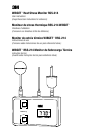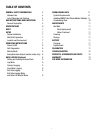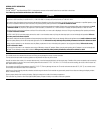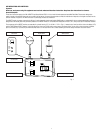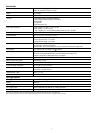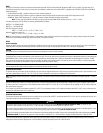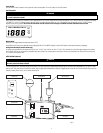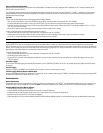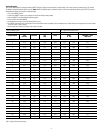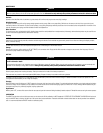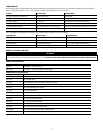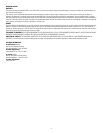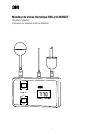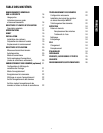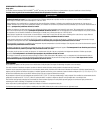
7
WBGT
According to the American Conference of Governmental Industrial Hygienists (ACGIH), the Wet Bulb Globe Temperature (WBGT) can be a useful, first-order index of the
environmental contribution to heat stress. It is influenced by air temperature, radiant heat, and humidity. WBGT is a weighted sum of DRY BULB, WET BULB and VERNON
GLOBE temperatures.
• Dry Bulb Temperature (DB) - provides a measure of simple “ambient temperature.”
• Wet Bulb Temperature (WB) -provides a measure of evaporative cooling including effects of airspeed and humidity. WB is always lower than DB.
• VERNON (6" black) GLOBE Temperature (GT) - provides a measure of radiant heat load including air speed effects.
Note: The 3M
™
Heat Stress Monitor’s Mini Globe is a Vernon Globe equivalent MINI GLOBE provides gt where gt = 2/3 GT + 1/3 DB.
The above temperatures (GT, WB, DB) are summed to generated WBGT as follows:
WHERE GT = 6" VERNON GLOBE
WHERE gt = 1.63" MINI GLOBE
With Direct Exposure to Sunlight
WBGT
out
= 0.7 WB + 0.2 GT + 0.1 DB = 0.7 WB + 0.3 gt
Without Direct Exposure to the Sun
WBGT
in
= 0.7 WB + 0.3 GT = 0.7 WB + 0.45 gt – 0.15 DB
Note: For more information on using WBGT reading in the assessment of both heat stress and strain when evaluating the risk to worker safety and health, the American
Conference of Governmental Industrial Hygienists Thermal Stress TLV should be consulted.
SETUP
Sensor Installation
Remove the WIBGET monitor and its Dry Bulb, Wet Bulb and Globe sensors from the carrying case. Holding each sensor in turn by its connector plug, align it vertically and
rotationally with its receptacle (as indicated by symbols on top of the unit), then push it firmly into place. An audible ‘click’ indicates full engagement.
CAUTION
Do not twist sensors once inserted into the base unit. Doing so may damage the sensor or sensor connector.
Wet Bulb Preparation
The Wet Bulb sensor requires careful attention to help maintain accuracy. The wick (or sock) must be replaced at the first sign of discoloration, stiffness or poor wetting (see
MAINTENANCE section). Fill the reservoir and wet the wick using distilled (or demineralized) water. A bottle and demineralizer are provided with the instrument. The Wet
Bulb reservoir may be filled, without impacting instrument readings, by adding room temperature water to the sponge (not to the wick). Refilling is normally required daily.
Conditions of low humidity, high temperature or high air speed may require more frequent refilling.
CAUTION
The wet bulb wick must remain wet during operation to help maintain the accuracy of the sensor.
Location and Environment
For optimum accuracy the sensors should be positioned in an open space and approximately three to six feet (one to two meters) above the floor or ground within the work
area. When radiant loading is high {GT = DB + 20 °C (68 °F)}, careful consideration must be given to shielding the Dry Bulb sensor.
Note: For additional information and guidance on assessing heat stress in the work environment consult the American Conference of Government Industrial Hygienists – Thermal
Stress TLV’s.
CAUTION
Keep all connectors clean and dry. If a connector becomes wet, it must be thoroughly dried prior to instrument usage. Condition of the sensor receptacles may be tested
by removing all sensors, turning the unit on and checking that all functions read 0.0 ± 0.3°C or 32.0 ± 0.5°F. If these are not the readings, do not use until the reason has
been determined and corrected.
Do not expose dry bulb (DB) to temperatures above 65°C (150°F). This may damage the base unit. To monitor environments above 65°C (150°F), use a remote sensor set
accessory and relocate the base unit to a cooler area.
OPERATING INSTRUCTIONS
The following instructions are intended to serve as a guideline for the use of the 3M
™
WIBGET
™
Heat Stress Monitor RSS-214. It is not to be considered all-inclusive, nor is
it intended to replace the policy and procedures for each facility.
If you have any doubts about the applicability of the equipment to your job situation, consult an industrial hygienist or call 3M’s Occupational Health and Environmental
Safety Division Technical Service Department at 1-800-243-4630. In Canada, call Technical Service at 1-800-267-4414.
WARNING
This monitor helps to measure certain environmental factors that can contribute to heat stress. Misuse may result in sickness or death. For proper use, see
supervisor or User Instructions, or call 3M in U.S.A., 1-800-243-4630. In Canada, call Technical Service at 1-800-267-4414.
Each person using this equipment must read and understand the information in these User Instructions. Use of this equipment by untrained or unqualified persons, or use
that is not in accordance with these User Instructions, may adversely affect product performance and result in sickness or death.
Use only for monitoring environmental factors which the sensors and instrument are designed to monitor. Failure to do so may adversely affect product performance and result
in sickness or death. For proper use, see supervisor or User Instructions, or call 3M in U.S.A., 1-800-243-4630. In Canada, call Technical Service at 1-800-267-4414.



